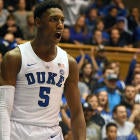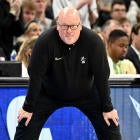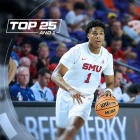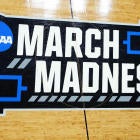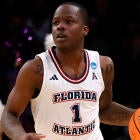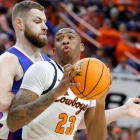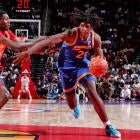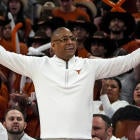It's quite clear at this early stage in the scouting and evaluation process for the 2019 NBA Draft that Duke's Zion Williamson has become the No. 1 prospect. He's in his own tier with a combination of sky-high projectable potential and quality production. But not long ago, it was his teammate, RJ Barrett, who owned that distinction.
Barrett came into the season as the No. 1 player in last year's high school class, and was expected to be the No. 1 prospect in the 2019 draft crop as well, but his weaknesses have led to questions about how quickly Barrett can adapt to the highest level of the game. To this point, Williamson has usurped Barrett as the draft's top prospect through two-thirds of the regular season.
But Barrett's offensive production, polished all-around game and physical profile that fits in the modern NBA -- and where the league is headed -- all make Barrett a lock to go in the top-5.
Yes, Barrett is leading Duke in scoring. Yes, he's still probably going to be a top-5 pick. But an amalgamation of inefficient scoring, lack of sustained success getting buckets in open shooting situations, and ball-dominant tendencies have all led to questions about how his skill set will translate at the next level. Is he the next Monta Ellis, a player you could plop comfortably in the modern NBA and potentially thrive? Is he an OJ Mayo clone, with an instinctual ability to score? Is he a star-in-waiting, or a projectable second-fiddle scorer? In what system does he fit best?
The questions about his game loom unanswered at Duke in an ISO-heavy system predicated on the best players finding their own offense in a spread system, and Barrett's game has been laid bare.
Off screen opportunities
According to data from Synergy, Barrett rates in the bottom 32nd percentile nationally in off-screen offense, be it peeling off screens to shoot off his left side (he's left-handed) or peeling off screens to shoot from his right side (where he shoots 42.9 percent of the time but averages just .667 points per possession, ranking in the bottom 23rd percentile). This does not preclude drives off pick-and-rolls or high screens, the latter of which he's quite comfortable with.
See below as he uses a high screen action from Marques Bolden to unleash his lanky strides towards the rim, scoring while taking contact. He puts Ty Jerome, an excellent perimeter defender for Virginia, in the spin cycle when it looked as if UVa had all sides covered on defense. Barrett didn't even need the full pick action, just a brief rub to get a switch, and then get to the rim.
Barrett sometimes goes against the grain in screen opportunities, too. His creative instincts can be both his biggest asset and biggest detriment. Here below you can see he gets a screener, politely says "thanks, but no thanks," and his impatience results in a suboptimal floating runner. Even a pass to cutting teammate Javin DeLaurier looked open, but he didn't see him and instead misses a low percentage shot.
One final snapshot of Barrett off the screen comes custom-fit with a really nice decision. Now, decision-making for Barrett is sometimes up and down overall, but in this action he smartly realizes that four defenders have folded within arms-reach of him in the paint, and kicks to the corner for an open 3-pointer and make from Cameron Reddish.
Catch and shoot opportunities
Barrett also rates in the bottom-half nationally in spot-up opportunities, which is where he generates most of his offense. This is an area where he will need improve at the next level to fulfill his potential, and for a projected top-5 pick, ideally, you'd expect more.
He's shooting only 31.4 percent from the 3-point line on the season, which again, is acceptable. But in catch-and-shoot opportunities in the half court, he struggles to consistently knock down shots. See below as Barrett welcomes a pass at the top of the key in a game against Syracuse, pass fakes to create space, and misses a clean look at a long ball.
Barrett's miss is not unusual here. According to Synergy, in half court situations, Barrett takes 53.1 percent of his shots in catch-and-shoot scenarios completely unguarded, making only 26.9 percent of those attempts; that number is 30.4 percent when guarded, closer to the NCAA average.
In half-court situations, where Barrett generates a good chunk of his offense off jumpers, he's capable of making those shots. Take another instance against Boston College, shown below, where he waits to be teed up on the perimeter from point guard Tre Jones. Barrett's instincts make him aware that, while his man is denying on the perimeter, he has enough space to get his shot off with ease. The result is Barrett anticipating the pass and getting off his shot before his defender can close. Not bad defense, but great offense. He was locked and loaded and knew he had enough separation to get a clean look.
And another, earlier this season. Barrett slides into the weak spot of the Syracuse zone on the perimeter and confidently buries a triple off the catch. An easy look, an effortless release, and a make with some swagger. Confidence is not an issue with Barrett, but consistency is. Even in a system where he's sometimes featured as a ball-handler, the majority of his offense comes in spot-up situations. Projecting him to the NBA level, he could play on or off the ball, but is likely best off -- which means these situations he will need to improve in to earn big minutes at the next level.
Moving without the ball
Barrett has the ball in his hands often. His usage rate of 33.1 ranks 16th in college basketball, and third among all freshmen. But when he doesn't have possession, he does a nice job slithering to open spots to get free. It's part feel, part instincts and high IQ. Below, you can see that the Pitt defender assigned to him gets caught ball-watching, and Barrett makes him pay by crab-legging his way to the open space in the corner for a 3-pointer. It's a miss, but a good example of his instincts to fill gaps on offense when he doesn't have the ball in his hands. When plays break down, his feel comes to life. His scramble mode is already advanced, and his polish offensively shows in this department.
In another instance against Pitt, Barrett dumps the ball to Zion Williamson and immediately finds the open space on the floor. Instead of dropping to the corner, where he likely brings his defender in a position to double Williamson (and likely doesn't get a clean look, as his defender predicts he will move to the corner), Barrett throws a curveball by shuffling to the top of the key. Big man Marques Bolden thinks he's about to get an open look from 3-pointer, too, as he scoots out to the perimeter. But meanwhile, Barrett identifies Bolden's motion and uses him as a quasi-screener.
Because Barrett identified that he could use Bolden as a shadow to sneak open at the top of the key, he gets a clean look at a 3-pointer from the top of the key.
Sometimes the less structure and the more feel Barrett can use, the better it works. With his long strides and finishing ability, he's a great transition player. He's also very good at creating space and open looks for himself and his teammates. His movement and instincts off the ball show there is another level still waiting to be developed and polished, if not at Duke, then at the NBA level.
The last word
In pick-and roll-opportunities, defenses are learning that to defend Barrett, working over the top of screens is not a necessity. Barrett doesn't yet have the consistent outside shot to make teams pay for cheating on screens, thus allowing the screener's defender to apply pressure.
Teams still respect Barrett because of his scoring, play-making and ball-handling, but unlocking his potential to becoming an NBA All-Star -- or even just a really good NBA wing -- is still a work-in-progress. The physical profile, the basketball IQ, and the ability to get looks without the ball in his hands are all there, and his polish offensively is on full display at Duke. But the difference between potential star and perennial All-NBA wing might be the gap between what he has at his disposal now, and what he can eventually add to his game on offense in months and years to come.













